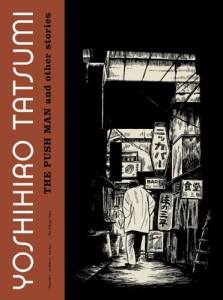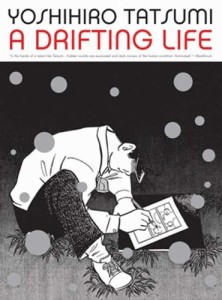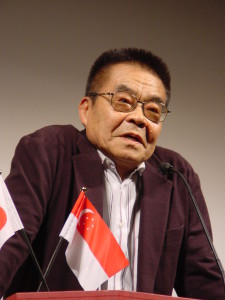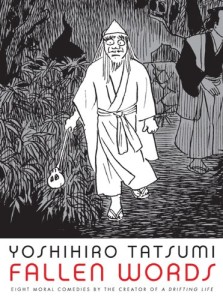See my Introduction for more information about the “Twenty Writers, Twenty Books” project. The current list of reviews and essays may be found at the “Twenty Writers” home page.
Last night I learned Japanese manga artist Yoshihiro Tatsumi had passed away at the age of 79. Revered as the grandfather of gekiga (a darker form of manga, akin to graphic novels or alternative comics here in the United States), Tatsumi was known in Japan for his urban, noirish comics featuring a gamut of characters, from gangsters and back alley hoods to college students and office workers. Only in the last ten years did he became well-known in the North America (and perhaps elsewhere) due to new translations of his work published yearly by Drawn & Quarterly and edited under the guiding hand of Adrian Tomine (Optic Nerve, Shortcomings).
I don’t think I can express how much I enjoyed Tatsumi’s work or how his comics encouraged and shaped my own writing. I did not come to his work via manga (a form I honestly don’t know much about) but rather by accident while browsing the shelves at a local bookstore. The cover—a lone man in a raincoat receding down a seedy nighttime alleyway, his back to the viewer—led me to pick up The Push Man and Other Stories and read the first story, then the next, then the next. I promptly purchased the copy, returned home, and read the entire collection in one sitting. My only disappointment was that none of his other work was readily available in the U.S. at the time. (My novella Everywhere Man gets its name from Tatsumi’s Push Man, and takes a few other cues as well.)
It was remarkable, this voice from Japan whose stories respected their source culture while also digging up explosive emotional power directed at that same culture. Tatsumi’s minimalist style and quiet stories of “average” people are often compared to Raymond Carver, but they’re also deeply infused with American noir and crime fiction. Themes of sexual frustration and violence and emasculation are rampant in Push Man and elsewhere. His characters often seem like Japanese counterparts to Jim Thompson’s West Texas oilcatters and door-to-door salesmen: disposable men on the edge of breakdown or abandonment, with few choices other than to jump on the accelerator and push through their troubles rather than backpedal out of them. They rarely succeed. Tatsumi’s characters live in cramped rooms, cramped even by Japanese standards, usually only large enough for a futon and a hot plate. They sludge through dead-end jobs while watching from afar Japan’s miraculous economic boom of the 1960s and 70s. They aren’t preoccupied with death, they fear being erased. I have the idea these stories were intended for the same kind of audience Jim Thompson wrote for, young lonely men who felt shut-out from the American—or Japanese—Dream.

The Push Man and other stories (2005)
When recommending Tatsumi to friends, my trouble has always been what not to recommend. Of Drawn & Quarterly’s offerings, perhaps only the autobiographical A Drifting Life and Black Blizzard (penned when Tatsumi was 21 and the source of some embarrassment for him when reprinted) are reserved for Tatsumi completists. Otherwise the English editions we have available represent an impressive body of work which, as I understand it, remains an incomplete record of his full output.
In Push Man‘s stories, each limited to eight pages, Tatsumi deftly compresses grim situations down to their bare minimum and yet manages to leave himself the occasional panel for bleak panoramas of late-1960s Tokyo, its late-night bars and red light districts and walk-up ramen stands. The artwork is sometimes cartoony—even clunky—but the emotional force of his characters’ desolation carries through page after page. In later collections (Abandon the Old in Tokyo, Good-Bye, and Midnight Fishermen) the young men’s magazines Tatsumi was writing for opened up more pages for his work. His pen improves in these collections, trending toward photorealism and employing heavier use of shadow and contrast. These tightly-wound tales sometimes suffer from the breathing room four or eight additional pages allowed, but each collection stores more than a few gems.

A Drifting Life (2009)
Tatsumi’s autobiographical A Drifting Life is his most ambitious work translated to English, and perhaps his most ambitious work of all. Intense but careful to withhold the most personal details of his life from the reader, Tatsumi lays out his formative years and how he entered the manga field while in elementary school. Each stage of his life is a new round of jousting with manga as an art form, tackling a narrative outlet he found liberating and yet restrictive and overly commercial all the same. I wish more time was spent on the side story of the manga rental industry in postwar Japan and its power to create and demolish artistic reputations. Some of the editors and publishers Tatsumi fought with sound straight out of Hollywood’s star system, right down to the shoddy treatment writers on both sides of the Pacific endured to produce consumable work week after week.
Still jousting with the strictures of manga at the age of 74, Tatsumi published Fallen Words, eight “moral comedies” inspired by rakugo, a venerable form of Japanese performance where a seated speaker narrates a story with a fan and a cloth as props. Rakugo performers will often tell stories that have been repeated for over a hundred years; the art is in the retelling and voices and mannerisms and novel uses of the props themselves. Tatsumi took this verbal art form and produced visual versions that depicted them in their original Meiji- and Edo-era settings: “I attempted to take rakugo, where laughter is supreme, and to tell the stories in the visual language of gekiga,” an art form not known for its comedy. Some stories rely on twist endings that don’t quite work, some on puns that only makes sense to Japanese speakers, but the book as a whole demonstrates the kind of experimentation Tatsumi was willing to engage in right to the end of his career.
When I was a graduate student teaching undergraduates creative writing, I included one story from Push Man as required reading. “Make-Up” remains my personal favorite of his work. It involves a young office worker living with an older woman, a bar hostess. When she’s gone at night, the young man dons a kimono, applies her cosmetic, and takes to downtown Tokyo passing as a woman. Not only is it remarkable the ease with which Tatsumi tells this nuanced story (another woman falls in love with him as a woman), it’s also surprising the sensitivity and compassion he offers his main character without falling into bathos. Some of the students tripped up on the simple lines of Tatsumi’s pen, some had trouble with the quietness (entire pages lacking a line of dialogue), but many gripped that something interesting and surprising was going on, right up to the ambiguous ending that opens up rather than shuts down the story.
Tatsumi’s work is often criticized as heavy-handed, cliched, and moralizing, which is arguable for his earlier output (such as Push Man) but is not so easily asserted with Drifting Life or Fallen Words. My response is to look at the boldness of the subject matter, the narrative distillation of complicated situations converted to deceptively simple panels on the page, and his early mastery of story structure. Each page of “Make-Up” is a self-contained scene, as perfect as a zen koan. It’s harder than it looks. That’s what I think Yoshihiro Tatsumi’s detractors are missing. This was not a natural talent who slipped into the form with ease, but one who struggled with it and attacked its firmaments, sometimes with mediocrity, sometimes brilliantly, but always thinking of his next push forward.
More on Yoshihiro Tatsumi’s passing: Adrian Tomine, Paul Gravett, Bleeding Cool.

